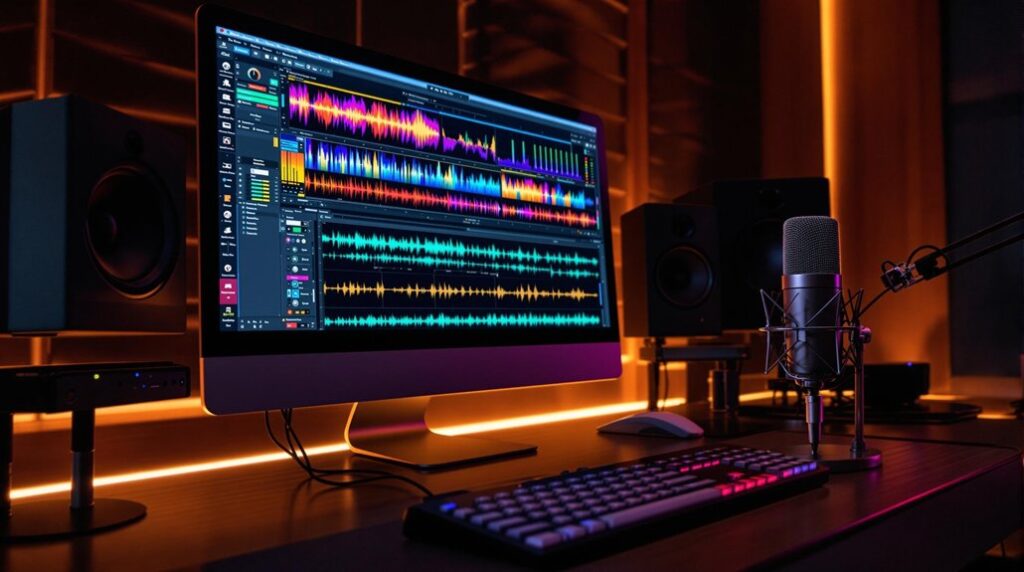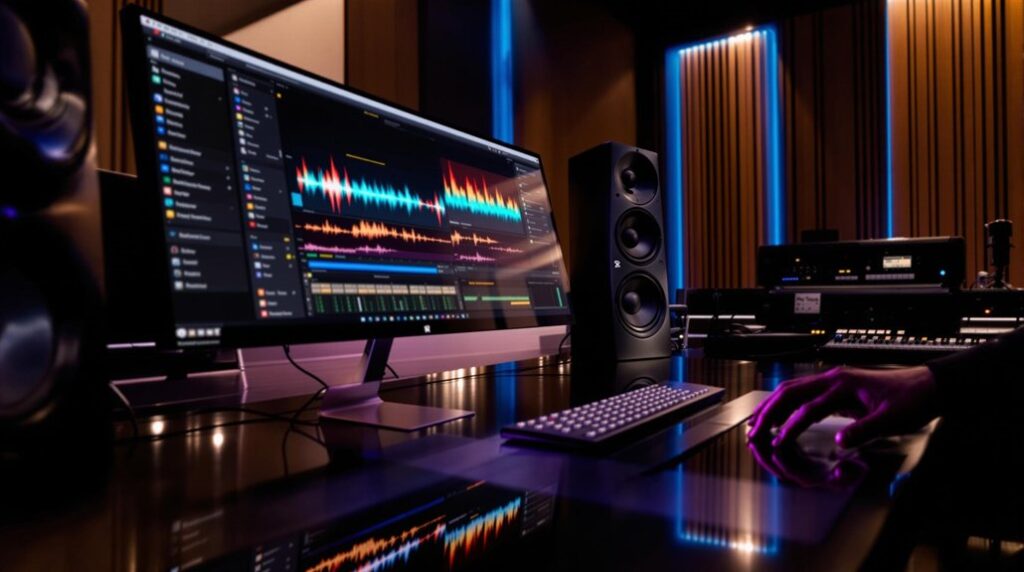Mastering the Pro Tools Transport Window is critical for seamless interaction within your audio projects. Access this essential interface via Window > Transport to manage metronome settings, MIDI merge options, and tempo adjustments. Key playback and recording functions include utilizing the play and stop buttons and employing Half-speed capture to control audio flow. Configure pre-roll and post-roll for tailored lead time and phrase conclusions using the green flags for quick identification. Optimize MIDI settings for accurate tempo and meter adjustments, and activate loop playback for efficient track auditioning. Explore further to enhance your audio production capabilities.
Key Takeaways
- Access the Transport Window via Window > Transport for essential Pro Tools controls such as playback and recording functions.
- Customize the Transport Window's display through the View menu to suit your workflow preferences and enhance efficiency.
- Use pre-roll and post-roll settings, toggled by Command K (Mac) or Ctrl K (Windows), for seamless recording transitions.
- Activate the metronome and configure MIDI settings for accurate timing and tempo adjustments during recording sessions.
- Utilize loop playback and the Tempo Ruler to experiment with takes and adjust tempo without altering recorded tracks.
Understanding the Transport Window
In the realm of digital audio workstations, the Pro Tools Transport Window serves as a pivotal component, offering a streamlined interface that integrates seamlessly with both the edit and mix windows.
This floating interface can be accessed via Window > Transport and is designed without title or scroll bars, ensuring unobtrusive operation.
Key functionalities within the Transport Window include metronome settings, MIDI merge options, and tempo adjustments, all critical for optimizing music production workflows.
Users benefit from customizable display settings, with location indicators and counters that can be toggled through the View menu.
To further enhance your workflow, you can integrate MIDI controllers for real-time manipulation of sound parameters, which can increase efficiency in Pro Tools.
Keyboard shortcuts are available for numerous commands within the Transport Window, enhancing efficiency and facilitating seamless navigation, making it an indispensable tool in professional audio production environments.
Playback and Recording Essentials
A multitude of functionalities within the Pro Tools Transport Window are critical for mastering playback and recording essentials, offering precision control over audio workflows. The Play button enables playback from the current counter position, while the Stop function, accessible via the space bar or zero key, halts audio instantly. The Return To Zero and Go to End commands facilitate swift navigation through sessions. For recording, holding Shift + Control (Mac) or Shift + Ctrl (Windows) enables half-speed capture, ensuring meticulous input. Track input-only monitoring delivers untainted signal reception, essential for pristine recording. Rewind and fast forward capabilities offer defined session traversal, complemented by optional audio playback for situational awareness. Maintaining input levels under -12dBU is crucial to prevent digital clipping and ensure high-quality recordings.
| Command | Functionality |
|---|---|
| Play/Stop | Initiate/terminate playback |
| Return To Zero/Go to End | Navigate session start/end |
| Track Input Monitoring | Isolate current input signals |
Configuring Pre-Roll and Post-Roll
Ever wondered how to achieve seamless shifts in your audio sessions? Mastering the intricacies of pre-roll and post-roll in Pro Tools is essential for ideal workflow.
Pre-roll initiates playback before the start field, providing essential lead time for performers to prepare. Conversely, post-roll extends playback beyond the end field, ensuring musical phrases conclude naturally.
Active pre-roll and post-roll are indicated by green flags, allowing for easy identification. Adjustments to their durations can be precisely made within the timebase ruler, offering tailored control over session dynamics.
For efficient toggling, use Command K on Mac or Ctrl K on Windows. The pre and post-roll fields detail specific playback regions, with zero values enabling indefinite playback, enhancing session fluidity.
Understanding the Pro Tools signal flow is crucial for achieving professional-quality audio results, as it influences the clarity and flexibility of your mixes.
Optimizing MIDI and Metronome Settings
While optimizing your MIDI and metronome settings in Pro Tools, understanding the MIDI controls within the transport window is vital for precise session management. The transport's MIDI settings enable significant adjustments to tempo and meter, with the metronome activation signaled by a blue indicator, essential for timing accuracy across MIDI Tracks. Utilizing the "Wait for Note" function is advantageous for solo engineers, pausing recording until a MIDI event is detected, thereby ensuring seamless workflow continuity. The metronome's double-click access provides a user interface for customizing its parameters, including tempo and meter, to synchronize with session needs. Enabling MIDI merge is essential for integrating new MIDI data into existing tracks, fostering efficient loop construction and refinement during recording. Configuring MIDI devices in Pro Tools First ensures that all connected equipment is recognized and properly set up, maximizing control over your MIDI sessions.
Loop Playback and Tempo Management
Master the intricacies of loop playback and tempo management in Pro Tools to enhance your audio production process. Loop playback is pivotal for efficient auditioning of multiple takes, facilitating a streamlined workflow in performance refinement. Distinguish it from loop recording, which overwrites existing regions. Activating loop playback is done via the Options menu, while loop record mode is accessible through the record enable button. The Tempo Ruler enables real-time tempo adjustments without compromising previously recorded material. Employ MIDI merge to integrate new MIDI data with existing tracks, perfect for evolving drum patterns. For precise editing, it's crucial to understand the difference between Grid Mode and Slip Mode in Pro Tools. Utilize the following table for quick reference:
| Feature | Functionality |
|---|---|
| Loop Playback | Repeat listening without overwriting regions |
| Loop Record Mode | Captures new takes, overwriting existing regions |
| Tempo Ruler Enable | Allows real-time tempo changes |
Frequently Asked Questions
How to Show Transport Window in Pro Tools?
To display the Transport Window in Pro Tools, navigate to the "Window" menu at the top of the interface and select "Transport." This operation is fundamental for accessing essential transport functionality, enhancing workflow efficiency during audio production.
How to Bring up a Window in Pro Tools?
To bring up a window in Pro Tools, utilize the Window Navigation features by accessing the menu bar. Select 'Window' and choose the desired window from the dropdown menu for efficient workflow management and enhanced user interface interaction.
What Is the Shortcut for Transport in Pro Tools?
The keyboard shortcut for accessing the Transport window in Pro Tools is Command + 1 on Mac or Ctrl + 1 on Windows. This facilitates efficient track management by streamlining access to playback and recording controls during sessions.
Under Which Menu Can You Show or Hide the Transport Window in Pro Tools?
The Transport Window in Pro Tools can be shown or hidden by accessing the Transport Options through the Window menu. This feature aids in enhancing workflow efficiency by allowing users to seamlessly toggle between different workspace configurations.
Conclusion
The thorough understanding and mastery of the Pro Tools Transport Window are essential for maximizing workflow efficiency and precision in audio production. Mastery of playback and recording essentials, as well as the configuration of pre-roll and post-roll settings, enhances session fluidity. Optimizing MIDI and metronome settings, alongside effective loop playback and tempo management, further refines project execution. By utilizing these advanced functionalities, professionals can achieve superior control over their audio projects, ensuring high-quality outcomes in complex production environments.




